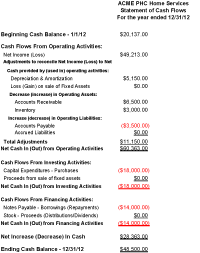In the last installment of this series we focused on the income statement. We looked at the various components of it and some examples of income statements. Recently, a number of contractors have asked about the difference between profit and cash. Because of those questions, I’m going to focus specifically on that question and the financial statement that deals with that topic. We’ll take a more in-depth look at the balance sheet in the next installment of this series.
One of the questions posed by a contractor was “How come the net profit on my income statement is so much more than the money I have in the bank? Where did it go?” Let’s take a look at the Statement of Cash Flows and profit vs. cash.
The Statement of Cash Flows is concerned with the flow of cash into and out of the business over a specific period of time. It is also known as the Cash Flow Statement. It shows how cash is moving through the business for the month, quarter or year. This makes the Statement of Cash Flows a good resource to determine the company’s ability to pay its bills in the near-term.
Below is the basic equation involved in determining the company’s ending cash balance for a period of time. Statements of Cash Flow are commonly done on a monthly, quarterly and yearly basis. (Note: This does not mean that we only look at our cash position at those points in time. Cash flow management should be done on a daily basis!)
Cash balance at the beginning of the period + Cash received during the period - Cash spent during the period = Cash balance at the end of the period
The disconnect between profit and cash is often confusing to business owners. That’s because many accounting professionals focus too much on accrual-basis accounting and don’t teach the owners cash-basis accounting principles.
Revenue is created when you make a sale to a customer. Profit is what’s left of the revenue after the expenses are accounted for. (Note: If expenses exceed revenue, then you have incurred a loss.) Cash is created when you actually collect money from the invoices. Profits do not equal cash! You don’t pay your bills with profits. You pay your bills with the cash received from the sales made.
It’s possible for a company to be profitable and yet be cash-starved. How so? Their sales may be really high but most of the sales could be on account (i.e., accounts receivable). If their customers are slow to pay, it could really hinder their cash flow. What if they have large jobs that require a lot of material to do the job? The payments due to the suppliers could be due well before the payments from the customers come in.
It’s also possible for a company to have strong cash flow yet not be profitable. Of course, this model could not be sustained over the longer-term. You’d eventually run out of cash and have to close the business.
Let’s now take a look at things from a cash-basis perspective. We need to look at the sources (inflows) and uses (outflows) of cash for the company. Cash will come into and go out of the company through three types of activities:
- Operating Activities — These are the transactions that relate to the selling of your goods and service to customers (i.e. materials purchased, wages paid, overhead expenses, etc.)
- Investing Activities — These are the transactions that relate to the purchase or sale of the company’s fixed assets (i.e. vehicles, equipment, buildings, etc.)
- Financing Activities – These are the transactions that relate to obtaining or repaying loans from creditors and investors (loans from banks, paying dividends or issuing stock).
Exhibit 1 shows a sample Statement of Cash Flows. Let’s go over the components of the sample Statement.
Start with the cash balance at the beginning of the period. In this case, it’s for the year. Now, we need to see how the cash balance changed throughout the year. We start by reviewing the things that impact cash from the company’s operations. That would be net income for the year from the income statement. We have to add back depreciation & amortization expenses because those are non-cash transactions.
Next, we have to look at changes in the balances of current asset and current liability accounts from the prior period balance sheet. How have they changed over the year? If a current asset’s balance increases, then that is a decrease in cash. For example, if your inventory goes up during the year, then that means you bought more materials than you sold. If your accounts receivable goes up, that means you billed more than you collected. Again, that means your cash has gone down. The reverse holds true as well. If your accounts receivable goes down, that means that you’ve collected more cash so your cash goes up. This holds true for all current assets.
Now, let’s look at current liabilities. If accounts payable goes up, that means cash goes up. You’ve bought more than you’ve paid for during the year. Again, the reverse holds true as well. If your accounts payable go down, then your cash goes down because you’ve paid more than you bought this year. This “rule” holds true for all current liabilities.
After you’ve adjusted net income for non-cash items and changes in the balances of current asset and liability accounts, it leaves you with the net adjustment to the cash account attributed to the operations of the company. In our sample Statement of Cash Flows, that amount is an increase of $60,363.
Now, we turn our attention to the cash flow that comes from the company’s investing activities. If we buy a vehicle or sewer machine, that’s a use of cash so our cash goes down. If, on the other hand, we sell one of our vehicles or any other fixed asset, then that gives us cash so cash goes up. The net result of these transactions will give us our adjustment to the cash account attributed to our investing activities. In our sample Statement of Cash Flows, that amount is a decrease of $18,000.
Next, we look at the cash flow that comes from the company’s financing activities. If we get a loan on our line of credit from the bank, then that gives us money so that would be an increase in cash. In the same way, if we make a payment on that line of credit, it would be a decrease in cash.
One part of this section that is often missed is the transactions related to the owners (shareholders). If the company sells more stock, that would be an increase in cash. If the owners put more money into the business, that would increase the cash balance as well. If the company paid a dividend or made a distribution to the shareholders, that would be a decrease in the cash balance. The net result of these transactions will give us our adjustment to the cash account attributed to our financing activities. In our sample Statement of Cash Flows, that is a decrease of $14,000.
Now we’re ready to determine the net change in the cash balance for the year. We do so by adding together the net adjustments in each of the three areas (operations, investing and financing). The result is the net change in cash balance. In our sample Statement of Cash Flows, that is an increase of $28,363.
Finally, we can determine the ending cash balance for the company for the year. Take the beginning cash balance ($20,137) and add the net change in cash flow ($28,363) to it to come up with the ending cash balance for the company. In this case, it’s $48,500. This ending result should equal the cash balance on the balance sheet for the company. If the net change was a negative amount, then you would subtract that amount from the beginning cash balance to get the ending cash balance.
The Statement of Cash Flows is probably the hardest of the three primary financial statements for business owners to understand. It’s also the least used on a regular basis, yet it’s probably the most important of the three. Because, if cash flow is not managed properly, the company can be out of business very quickly … even at its most profitable point in time!
In the next installment of this series, we will look at some things contractors can do to improve their cash flow management. We’ll also follow up with that detailed look at the balance sheet.
Michael Bohinc is a Certified Public Accountant in Cleveland, Ohio, and the owner of Keeping Score Inc. He has served as the Chief Financial Officer of Norhio Plumbing Inc., his family’s plumbing company in Aurora, Ohio, since 1988. He also currently serves as the Interim Director for the Service Nation Alliance – Plumbing Group. You may contact him via e-mail at [email protected]



